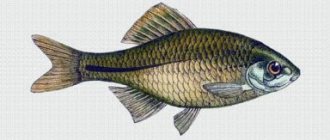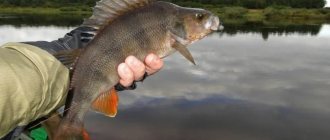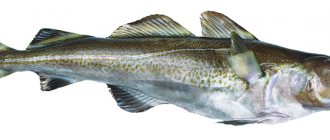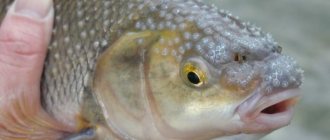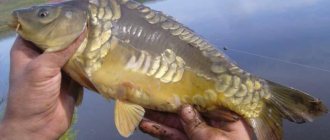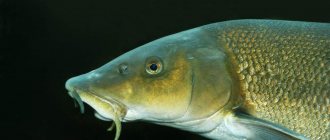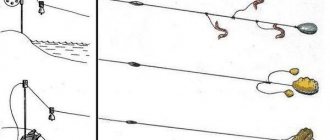Parrot fish
The parrotfish has a jaw shaped like a bird's beak. She gnaws coral reefs with her mouth.
These fish come in both aquarium and large specimens that grow up to two meters in length. They come in different colors - mostly bright tropical shades predominate.
LiveInternetLiveInternet
Quote from SASHOKI
Read in full In your quotation book or community!
Rare fish in the deep sea
In the middle of the last century, they began to actively study the underwater world. The bottom of the world's oceans is home to millions of different species, many of which are still unknown to us. Look at a selection of rare fish that humanity has discovered.
1. Ambon Scorpionfish (Latin: Pteroidichthys amboinensis).
Opened in 1856. Easily identified by its huge “eyebrows” - specific growths above the eyes. Able to change color and shed. Conducts a “guerrilla” hunt - camouflaging at the bottom and waiting for the victim. It is not uncommon and has been quite well studied, but its extravagant appearance simply cannot be ignored! (Roger Steene/Conservation International)
2. Psychedelic frogfish (English: Psychedelic Frogfish, Latin: Histiophryne psychedelica).
Opened in 2009. A very unusual fish - the tail fin is curved to the side, the pectoral fins are modified and look like the paws of land animals. The head is large, the widely spaced eyes are directed forward, like in vertebrates, due to which the fish has a peculiar “facial expression”. The color of the fish is yellow or reddish with sinuous white-blue stripes diverging in different directions from the blue eyes. Unlike other fish that swim, this species moves as if jumping, pushing off the bottom with its pectoral fins and pushing water out of the gill slits, creating jet thrust. The tail of the fish is curved to the side and cannot directly direct the movement of the body, so it oscillates from side to side. The fish can also crawl along the bottom using its pectoral fins, moving them like legs. (David Hall/EOL Rapid Response Team)
3. Rag picker (English: Leafy Seadragon, Latin: Phycodurus eques).
Opened in 1865. Representatives of this type of fish are notable for the fact that their entire body and head are covered with processes that imitate algae thalli. Although these processes are similar to fins, they do not take part in swimming and serve for camouflage (both when hunting shrimp and for protection from enemies). It lives in the waters of the Indian Ocean, washing southern, south-eastern and south-western Australia, as well as northern and eastern Tasmania. It feeds on plankton, small shrimp, and algae. Having no teeth, the rag picker swallows its food whole. (lecates/Flickr)
4. Moonfish (English: Ocean Sunfish, Latin: Mola mola).
Opened in 1758. The laterally compressed body is extremely high and short, which gives the fish an extremely strange appearance: it resembles a disk in shape. The tail is very short, wide and truncated; the dorsal, caudal and anal fins are interconnected. The skin of the moonfish is thick and elastic, covered with small bony tubercles. The sunfish can often be seen lying on its side on the surface of the water. An adult sunfish is a very poor swimmer, unable to overcome strong currents. It feeds on plankton, as well as squid, eel larvae, salps, ctenophores and jellyfish. It can reach gigantic sizes of several tens of meters and weigh 1.5 tons. (Franco Banfi)
5. Broadnose chimaera (lat. Rhinochimaera atlantica).
Opened in 1909. Absolutely disgusting looking jelly fish. It lives on the deep bottom of the Atlantic Ocean and feeds on mollusks. Extremely poorly studied. (Jay Burnett, NOAA/NMFS/NEFSC)
6. Frilled Shark (Latin: Chlamydoselachus anguineus).
Opened in 1884. These sharks look much more like a strange sea snake or eel than their closest relatives. In the frilled shark, the gill openings, of which there are six on each side, are covered with skin folds. In this case, the membranes of the first gill slit cross the throat of the fish and are connected to each other, forming a wide skin blade. Along with the goblin shark, it is one of the rarest sharks on the planet. No more than a hundred specimens of these fish are known. They have been studied extremely poorly. (Awashima Marine Park/Getty Images)
7. Indonesian coelacanth (English: Indonesian Coelacanth, Latin: Latimeria menadoensis).
Opened in 1999. A living fossil and probably the oldest fish on Earth. Before the discovery of the first representative of the coelant order, which includes the coelacanth, it was considered completely extinct. The divergence time of the two modern species of coelacanth is 30–40 million years. No more than a dozen were caught alive. (Pearson - Benjamin Cummings)
8. Hairy Angler (lat. Caulophryne polynema).
Opened in 1930. Very strange and scary fish that live on the deep bottom, where there is no sunlight - from 1 km and deeper. To lure the inhabitants of the deep sea, it uses a special luminous growth on the forehead, characteristic of the entire order of anglerfish. Thanks to its special metabolism and extremely sharp teeth, it can eat anything it comes across, even if the prey is many times larger and is also a predator. It reproduces no less strangely than it looks and feeds - due to the unusually harsh conditions and rarity of fish, the male (ten times smaller than the female) attaches to the flesh of his chosen one and transmits everything necessary through the blood. (BBC)
9. Blobfish (Latin: Psychrolutes marcidus).
Opened in 1926. Often mistaken for a joke. In fact, this is a completely real species of deep-sea bottom-dwelling marine fish of the psycholute family, which on the surface takes on a “jelly” appearance with a “sad expression.” It has been poorly studied, but this is enough to recognize it as one of the most bizarre. The photo shows a copy from the Australian Museum. (Kerryn Parkinson/Australian Museum)
10. Smallmouth macropinna (English, Latin: Macropinna microstoma) - winner for quirkiness.
Opened in 1939. It lives at very great depths, so it has been poorly studied. In particular, the principle of fish vision was not entirely clear. It was believed that she must experience very great difficulties due to the fact that she can only see up. Only in 2009 was the structure of the eye of this fish fully studied. Apparently, when trying to study it earlier, the fish simply could not tolerate the change in pressure. The most notable feature of this species is the transparent, dome-shaped shell that covers the top and sides of its head, and the large, usually upward-pointing, cylindrical eyes that lie underneath this shell. A dense and elastic covering shell is attached to the scales of the back at the back, and on the sides to the wide and transparent periocular bones, which provide protection for the organs of vision. This covering structure is usually lost (or at least very badly damaged) when fish are brought to the surface in trawls and nets, so its existence was not known until recently. Under the covering shell there is a chamber filled with a transparent liquid, in which, in fact, the eyes of the fish are located; The eyes of living fish are bright green and separated by a thin bony septum, which, extending backwards, expands to accommodate the brain. In front of each eye, but behind the mouth, is a large rounded pouch that contains an olfactory receptor rosette. That is, what at first glance appears to be eyes in photographs of live fish is actually an olfactory organ. The green color is caused by the presence of a specific yellow pigment in them. It is believed that this pigment provides special filtering of light coming from above and reduces its brightness, allowing the fish to discern the bioluminescence of potential prey. (Monterey Bay Aquarium Research Institute)
Rare fish of the world
Catfish that lives without water
A rather rare and little-studied fish from the order Catfish is the only known fish that can live without water. It is enough for her to glide along the wet surface of leaves on the banks of streams and rivers.
This slippery fish is somewhat reminiscent of a worm; it has no eyes, apparently because it spends most of its time underground. Nothing more is known about her.
See also: Migration of wild animals: photos from National Geographic magazine
Sole
Fish from the order Flounder (lat. Pleuronectiformes) are representatives of very strange vertebrates. Although they are born as completely normal fish, their skulls gradually become deformed as they age until both eyes are on the same plane. This feature allows the fish to acquire a flat body and skillfully camouflage itself on the seabed.
The sea tongue fish of the Cynoglossaceae family went even further: they completely lost their pectoral fins and developed a smooth drop-shaped body. Many species have an arched mouth.
Rare fish species
Sea devils
Sea devil fish of the family Thaumatichthidae boast one of the strangest appearances in the animal world. The upper jaw of these fish is often several times larger than the lower jaw; it is also capable of folding in half, allowing the fish to more easily suck prey into the throat. Each member of the family has a luminescent prey lure protruding directly above its mouth.
Long-snout fish from the order of monkfish have a very long bait, which can be 10 times longer than the body of the fish itself. It is interesting that all these creatures swim upside down, but none of the scientists can really say why.
Another family of monkfish, the Batfish, resemble the offspring of a turtle and a chicken. These fish have adapted to move along the seabed using their fins, which are used as paws.
See also: The most terrible killer fish
Thus, the fish seem to walk along the sandy bottom, looking for prey.
Mudskipper
One of the most famous fish that has the ability to live out of water is the mudskipper. She belongs to the Bychkov family and spends most of her time climbing the clay banks. On land, these fish can move much faster than under water.
The gill cavities of these fish are able to retain water for a long time. If their body remains wet, fish can breathe through their thin skin. Male spinyskippers are very territorial and constantly fight each other for influence.
The rarest fish
Blind fish climbing on rocks
Living in the subtropical regions of Thailand, the cave fish of the species Cryptotora thamicola has lost its vision and pigmentation during evolution. But this is not its only feature. This strange fish has adapted to fast cave currents: it can climb vertical surfaces.
The rough, sticky undersurface of its large fins allows the fish to climb and stay on slippery rocks in fast currents and even climb under waterfalls!


